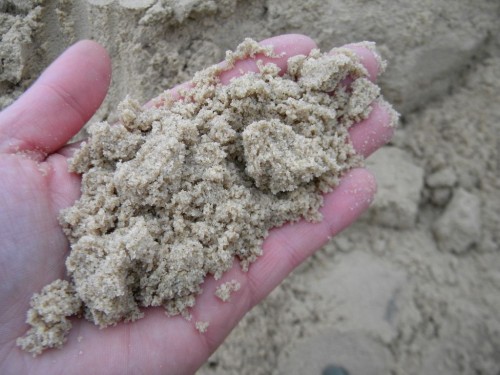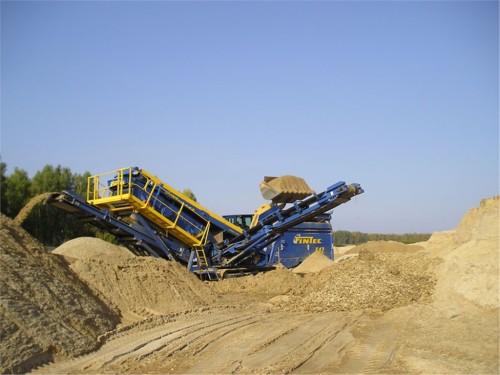Many builders who have some experience in this craft are not serious about the quality of sand, and ultimately face a variety of problems. It is surprising, but there is a tremendous number of variants of this rock, so the selection of sand is a responsible process.
Content
First of all, attention should be focused on the fact that there are certain standards, including the construction, in which it is expanded, which sand must be applied in certain conditions. Of course, it is worth noting that not only the quality of the works carried out, but the final result depends on this issue. One hundredth cases can be found in which the use of poor-quality sand led to colossal consequences. The negative sides of rock can manifest themselves in a month, and a year later, but one thing you need to know exactly - the problems will probably not succeed.
This example can be given in which the building mixture leads to cracking the walls and the base of the house. Accordingly, in such a situation it will not be possible to fix something.
In this material, we will consider the basic details related to the choice of sand for construction work, as well as analyze the most important characteristics of this breed, focus on the most important features of the resource.
Features Sand Use in Construction
Many may surprise it, however, the sand is an indispensable resource that is used in most construction activities. Moreover, this material is also used for small repair work, and when laying roads, as well as in many other areas. From this information it becomes clear that without this material it is impossible to present practically no large-scale work, primarily the construction, whatever volumes they have. It is necessary to separately note the fact that in the modern world the largest producers have already found a replacement for many materials, but only the sand is indispensable resources. First of all, this is due to its low cost. Almost every construction site you can find huge amounts of sand, which may not be fully used.
It is most important to keep in mind that the sand should be qualitative, and the requirements for this resource are the same high as, for example, to rubbn, cement and other building materials.
Often sand is used for the following purposes:
- rocking for alignment of roads and pita;
- as aggregate of cement and concrete solutions;
- to create an abrasive, filter, cargo.
Of course, the most important issue is precisely the second point, since the quality of concrete and cement structures has the maximum value in the construction activities of various scales. Unfortunately, in the market you can find a lot of poor-quality material, and you always need to remember. We will talk more about low-quality products further in this material.
It is also important to note that some builders adhere to the standard GOST 8736-93 "Sand for construction work". It is worth saying that today it is relevant, despite the continuous improvement of construction resources. In the event that we are talking about our own construction within the framework of the private territory, it should be understood that no standards will help here, since it will be necessary to personally check the quality of the material. If it speaks about standards, here often we are talking about the mass orders of sand, which will deliver directly the supplier itself to construction. For small in terms of work, it will be possible to be content with small, since the proposed sand often does not comply with some specific standards, and the sellers themselves simper themselves say that their resource is suitable for construction work.
Sand fractions
As for the sand fraction, this question is often analyzed in special laboratories. Often, the sand fraction is from 0.1 mm (small resource) to 3.5 mm (the largest material). During extraction it turns out that in the total volume of sand there are a wide variety of material fractions, but it is necessary to characterize the prevailing particle size.
If the sand has various fractions, as well as mixed color gamut, then it is about mixing the material. Such products should be treated extremely suspiciously, since the overall quality of sand may not comply with the requirements for construction work.
Experts argue that often the sand fraction is from 0.5 to 1.5 mm, and this gap is the best solution for use in construction work. Of course, for sand, which should be applied in the construction of responsible structures, where each element of the structure is of particular importance.
Sand features and production method
First of all, it should be borne in mind that the sand is obtained by the most diverse ways, and it depends on this question whether the resource is suitable for use in construction. Externally sand can be almost the same, but with a more thorough analysis it becomes clear that its characteristics differ significantly. Next, we consider the main features of the sand depending on the method of its production.
- Sea sand. This type of sand is extracted using a hydraulic or mechanical pump. It is worth saying that the material thus raise from the seabed, or after stripping the shores. It is worth emphasizing that sand particles here have an acute form, since at the bottom of the marine medium there is practically no flow. However, this is the advantage, since the acute-coronal material is better clips with other components of concrete or cement mixtures. Constructions become stronger and more durable. Unfortunately, this type of sand is used in construction not so often, as it is mined only near large marine objects, and transportation for long distances is not always beneficial.
- River sand. It must be said that it is river sand that is one of the best options for construction work. River sand particles have a streamlined (ground) surface, which provides high reliability when creating concrete or cement products. Good news is also the fact that it is not a problem to extract river sand - this is not a problem, since rivers are in large quantities in almost all regions. Moreover, river sand is also fairly enough to deliver to large construction. It is also reported that the total number of sandy products river resource takes 5% of the market. At the same time, for river sand mining, it is necessary to have appropriate equipment.
- Career sand (washed). It is also one of the most common ways of mining sand. It should be noted that when mining in the material there are many varied impurities. It is often clay, as well as the components of other breeds, so pre-material must be rinsed to get a resource suitable for construction work. On the market of this material about 15% of the total sand. It should also be said that when buying a similar resource, it should be personally to check its quality, since impurities can really seriously affect the properties of the sand.
- Career sand (seeded). This is the most common sand in the world, and its market share is 40%. Accordingly, this resource is mined in quarries, where the quality of the occurrence is in advance. Immediately after the sand was mined, he was immediately sent to the screens that sift the material. Often, the screens are located next to the careers to simplify the transportation of the sand. The most important feature of the material is its purity, since the presence of impurities is unacceptable here. Peschins often have sharp corners, which positively affects the quality of cement and concrete structures.
- Artificial sand. In recent years, artificial sand has also gained considerable popularity, and all thanks to its high quality. Often this type of sand is produced by crushing granite, marble and rubble. Accordingly, the strength of such a material is high. When fledging solid rocks, sharp grains are obtained, which are perfectly clutching with concrete. Unfortunately, artificial sand is too expensive, so in private construction it is practically not used. If you need the sand of the highest quality, then this option is almost indispensable.
Main features of quartz sand
It should be borne in mind that in for construction needs, it is often the quartz sand, and before applying it for construction needs, it should be noted the main areas of use:
- Flakes. Quartz sand in its composition has many silicate, so the material is often used to create glass. Moreover, often glass is obtained more than quality.
- Cleansing element. With the help of quartz material, surface cleaning can be carried out, as well as sand can be used as the main resource for water filters. Every year, experts open new cleaner possibilities of quartz sand.
In addition, if we are talking about the creation of cement or concrete products based on quartz sand, then often we get attractive surfaces that are canceled in different interiors. The surface of the surface is transfused and have pastel shades.
Features of impurities in the sand
As we have said, there may be various impurities in the sand, and it is worth remembering before construction work. In addition, it should be noted that in most products that are on the market, there are 20% impurities. It is worth noting the fact that in such conditions it is necessary to re-sift the material so that its quality corresponds to the requirements. Most often, impurity are too thin sand particles. Despite the fact that the faction is tiny, it negatively affects the quality of concrete. The bottom line is that smaller sand particles will block the passage of moisture through the concrete structure, and ultimately the quality of the structure will be rapidly falling.
It is also worth highlighting the sandy. These are sands, in which from 10 to 20% clay.
- Easy soup. This variety of sand has in its composition up to 15% clay. Thus, this sand can be safely used for finishing works, as well as to create roads. At the same time, the responsible concrete structures based on this resource is better not to build.
- Heavy Spring. It can be up to 20% of clay, so it is possible to use this material only for the moor of the walls of economic buildings.
People who have decided to conduct construction work should externally define the soup from pure sand. The quality of construction works directly depends on this. Thus, the soup often has a brown shade, and on the basis of this information, it certainly will not be able to confuse the material.
Using a Suglinka in construction
At the end I would like to note the features of the Suglinka. This is sand, which has up to 35% clay. Again, to create responsible concrete structures, this material is not suitable, but in some other cases this sand will be irreplaceable.
- The main feature of Suglinka is the fact that this sand has excellent waterproofing. Accordingly, the material can be used when creating roads, as well as other surfaces.
- In addition, a saman is created on the basis of Suglinka without problems - a durable building material, which is a strong blocks suitable for the construction of small economic structures.
- Also, many experts recommend using loams for filling the sinuses of the foundation, as well as wells. Well, in some cases, this sand can serve as a barrier for water or just small reservoirs.























